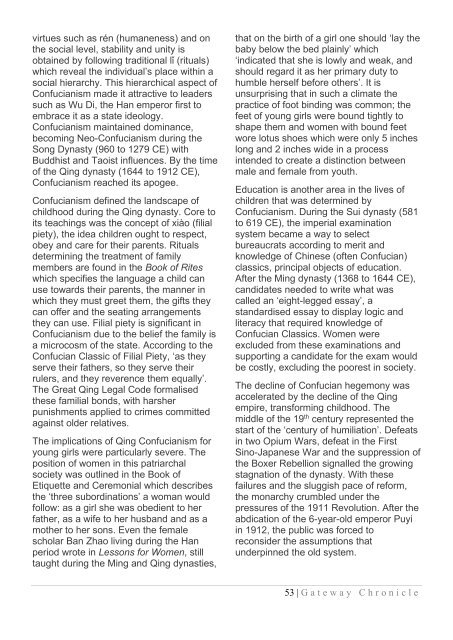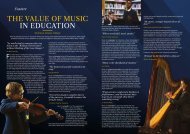Gateway Chronicle 2022
You also want an ePaper? Increase the reach of your titles
YUMPU automatically turns print PDFs into web optimized ePapers that Google loves.
virtues such as rén (humaneness) and on<br />
the social level, stability and unity is<br />
obtained by following traditional lǐ (rituals)<br />
which reveal the individual’s place within a<br />
social hierarchy. This hierarchical aspect of<br />
Confucianism made it attractive to leaders<br />
such as Wu Di, the Han emperor first to<br />
embrace it as a state ideology.<br />
Confucianism maintained dominance,<br />
becoming Neo-Confucianism during the<br />
Song Dynasty (960 to 1279 CE) with<br />
Buddhist and Taoist influences. By the time<br />
of the Qing dynasty (1644 to 1912 CE),<br />
Confucianism reached its apogee.<br />
Confucianism defined the landscape of<br />
childhood during the Qing dynasty. Core to<br />
its teachings was the concept of xiào (filial<br />
piety), the idea children ought to respect,<br />
obey and care for their parents. Rituals<br />
determining the treatment of family<br />
members are found in the Book of Rites<br />
which specifies the language a child can<br />
use towards their parents, the manner in<br />
which they must greet them, the gifts they<br />
can offer and the seating arrangements<br />
they can use. Filial piety is significant in<br />
Confucianism due to the belief the family is<br />
a microcosm of the state. According to the<br />
Confucian Classic of Filial Piety, ‘as they<br />
serve their fathers, so they serve their<br />
rulers, and they reverence them equally’.<br />
The Great Qing Legal Code formalised<br />
these familial bonds, with harsher<br />
punishments applied to crimes committed<br />
against older relatives.<br />
The implications of Qing Confucianism for<br />
young girls were particularly severe. The<br />
position of women in this patriarchal<br />
society was outlined in the Book of<br />
Etiquette and Ceremonial which describes<br />
the ‘three subordinations’ a woman would<br />
follow: as a girl she was obedient to her<br />
father, as a wife to her husband and as a<br />
mother to her sons. Even the female<br />
scholar Ban Zhao living during the Han<br />
period wrote in Lessons for Women, still<br />
taught during the Ming and Qing dynasties,<br />
that on the birth of a girl one should ‘lay the<br />
baby below the bed plainly’ which<br />
‘indicated that she is lowly and weak, and<br />
should regard it as her primary duty to<br />
humble herself before others’. It is<br />
unsurprising that in such a climate the<br />
practice of foot binding was common; the<br />
feet of young girls were bound tightly to<br />
shape them and women with bound feet<br />
wore lotus shoes which were only 5 inches<br />
long and 2 inches wide in a process<br />
intended to create a distinction between<br />
male and female from youth.<br />
Education is another area in the lives of<br />
children that was determined by<br />
Confucianism. During the Sui dynasty (581<br />
to 619 CE), the imperial examination<br />
system became a way to select<br />
bureaucrats according to merit and<br />
knowledge of Chinese (often Confucian)<br />
classics, principal objects of education.<br />
After the Ming dynasty (1368 to 1644 CE),<br />
candidates needed to write what was<br />
called an ‘eight-legged essay’, a<br />
standardised essay to display logic and<br />
literacy that required knowledge of<br />
Confucian Classics. Women were<br />
excluded from these examinations and<br />
supporting a candidate for the exam would<br />
be costly, excluding the poorest in society.<br />
The decline of Confucian hegemony was<br />
accelerated by the decline of the Qing<br />
empire, transforming childhood. The<br />
middle of the 19 th century represented the<br />
start of the ‘century of humiliation’. Defeats<br />
in two Opium Wars, defeat in the First<br />
Sino-Japanese War and the suppression of<br />
the Boxer Rebellion signalled the growing<br />
stagnation of the dynasty. With these<br />
failures and the sluggish pace of reform,<br />
the monarchy crumbled under the<br />
pressures of the 1911 Revolution. After the<br />
abdication of the 6-year-old emperor Puyi<br />
in 1912, the public was forced to<br />
reconsider the assumptions that<br />
underpinned the old system.<br />
53 | G ateway <strong>Chronicle</strong>


















